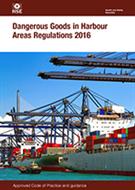Quick Search
Show me:
Dangerous Goods In Harbour Areas Regulations 2016, L155
Approved Code Of Practice And Guidance, L155
- Author:
- Health nd Safety Executive (HSE)
- Publisher:
- HSE Books

The Dangerous Goods in Harbour Areas Regulations 2016 (DGHAR) came into force on 1 October 2016.
About this guidance
The previous Approved Code of Practice on the Dangerous Substances in Harbour Areas Regulations 1987 (DSHAR) (COP18) and the relevant guidance document (HS(R)27) have now been withdrawn.
This guidance provides practical advice for anyone involved in activities in ports, harbours, jetties, docks and wharves on how to comply with duties under the Dangerous Goods in Harbour Areas Regulations 2016. The purpose of the regulations is to put in place specific measures to reduce the risk of a serious incident occurring when dangerous goods pass through harbours and harbour areas. They contain a set of safety provisions for dutyholders aimed at safeguarding ports against major accidents involving dangerous goods by coordinating activities between ship and shore. 'Dangerous goods' means goods meeting the criteria for classification as dangerous in the International Maritime Dangerous Goods (IMDG) Code.
What has changed?
-
Redundant, superseded or duplicated provisions of the previous legislation have been removed; the remaining sections have been updated and simplified and replaced by a new set of shorter, updated regulations
-
The definition in DSHAR of 'dangerous substances' has been replaced by 'dangerous goods' based on the latest applicable international standards. These are defined to cover all goods that meet the criteria for classification as dangerous under the latest IMDG Code and the regulations have been renamed the 'Dangerous Goods' in Harbour Areas Regulations to reflect that change
| Extent | N/A | ISBN | 9780717666553 |
|---|---|---|---|
| Size | N/A | Price | £21.10 |
| Format | Paperback | Published | 28 Sep 2016 |
| Availability | In Stock: 1 - 2 days | Delivery | Delivery options and charges |
